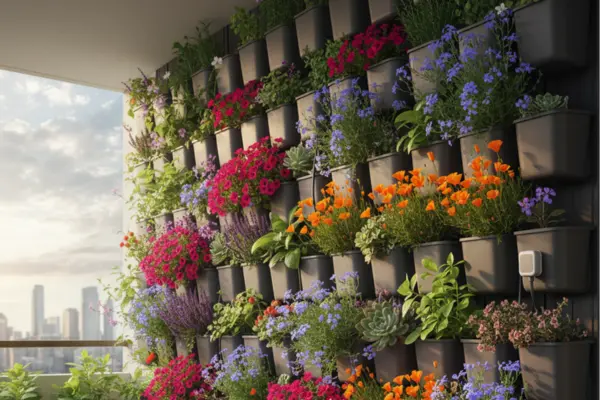Want the color and drama of a full flower display without babysitting a hose? Drought-tolerant flower towers are your answer. By combining efficient vertical planters with plants that naturally sip water, you’ll get months of bloom—even in hot, dry spells. The secret is choosing the right varieties, using a moisture-smart mix, and watering on a schedule that saves more than it spends.
This guide covers plant picks that laugh at heat, how to build a tower that doesn’t tip or dry unevenly, simple irrigation routines, and easy maintenance. You’ll get a weekend setup plan plus fixes for common issues so your tower stays vibrant on a lean water budget.
Why towers + drought-smart plants work so well
- Small root zones + airflow: Towers dry faster than beds, so plants that tolerate dryness thrive.
- Even exposure: Vertical sides catch light from multiple angles, pushing continuous bud formation.
- Precision watering: Short, targeted pulses reduce runoff and waste compared to hand-soaked pots.
- Space magic: A single square foot footprint can hold 20–60 planting pockets.
The best drought-tolerant flowers for towers
Sun-soaked champions
- Portulaca (moss rose): Succulent leaves, neon blooms, loves heat and sandy mixes.
- Lantana (compact/patio types): Butterflies adore it; nonstop clusters in warm palettes.
- Verbena (trailing): Strong bloomers and great spillers.
- Calibrachoa (million bells): Many modern varieties handle heat well once established.
- Gazania: Bold daisies that close at night; thrives in lean soil.
- Vinca (Catharanthus): Tough, glossy foliage and constant flowers.
Silver/gray foliage that keeps cool
- Helichrysum (licorice plant), dwarf artemisia, lamb’s ear ‘Silver Carpet’. Reflect sunlight, reduce transpiration, and look great with bright blooms.
Shoulder-season and part-sun backups
- Nemesia (heat-tolerant strains), dwarf marigold, zinnia ‘Profusion’.
Design tip: Use the classic thriller–filler–spiller idea in a vertical way: upright color up high (lantana), mounding fillers mid-tiers (verbena, vinca), and trailers (portulaca, calibrachoa) to soften edges.
Media recipe: hold just enough, never soggy
- Goal: Fast drainage + modest water storage + stable structure.
- Mix: 40% potting mix + 40% coco coir + 20% perlite/pumice.
- Why it works: Coco holds moisture without turning to muck; perlite/pumice keep air pockets open.
- Top-dress: 1–2 cm coco chips or fine bark to cut evaporation and protect surface roots.
- Avoid: Heavy compost loads or garden soil (compaction, poor flow).
Build a stable, even-drinking tower
- Choose a wide base with a low center of gravity. If windy, add a paver or sandbag inside the base tray.
- Plumbing: Run a central drip spine (1/4″ line) with 2 L/hr button emitters to each tier, or individual lines to the thirstiest pockets.
- Level matters: Check the base with a spirit level; a tilt sends water to one side, starving the other.
- Pocket lips: Models with small lips hold water long enough to soak in instead of spilling.
Watering schedules that save gallons
- Establish first (7–10 days): Water daily until roots grip the mix (morning only).
- Then shift: Every 2–3 days depending on heat and wind.
- Pulse irrigation (best with a timer):
- Baseline: 2 minutes ON, 10 minutes OFF × 2 cycles in the morning.
- Heatwave: 2 minutes ON, 10 minutes OFF × 3 cycles; add +1 minute for the top tier if it consistently dries first.
- Baseline: 2 minutes ON, 10 minutes OFF × 2 cycles in the morning.
- Hand-check by weight: Lift the tower slightly or a removable module—light = water now; heavy = wait.
- Night lockout: Don’t water after early evening; damp, cool pockets overnight invite disease.
Feeding blooms without forcing lush, thirsty leaves
- At planting: Mix in a slow-release balanced fertilizer (follow label for container rates).
- During bloom: Use a bloom-focused liquid feed every 2–3 weeks at half strength.
- If foliage explodes and flowers stall: Pause nitrogen; increase light or add a lightly shaded afternoon break to protect buds.
Weekend setup plan (copy this)
Saturday morning — Base & plumbing
- Place the tower on a level, firm surface; add base weight if windy.
- Run the central drip line; install 2 L/hr emitters for each tier; flush lines.
Saturday afternoon — Mix & plant
- Pre-wet the coco-rich mix until evenly moist.
- Fill pockets and plant:
- Top tiers: Portulaca, gazania, succulents.
- Middle: Lantana (compact), verbena, calibrachoa.
- Lower/part-shade: Vinca, nemesia, marigold.
- Top tiers: Portulaca, gazania, succulents.
- Mulch pockets with coco chips or fine bark.
Sunday morning — Program & test
- Set pulse schedule (2 × 2 minutes baseline).
- Run a full test; check for leaks and even drips.
- Rotate the tower 90° so the sunniest face doesn’t hog all the growth.
Sunday evening — Finishing touches
- Add soft ties to any lanky stems.
- Place a splash tray only during the establishment week (remove later to avoid soggy roots).
Heat, wind, and sun management
- Shade cloth (20–30%) during extreme heat keeps petals vivid and oils intact. Clip it so you can remove on cooler days.
- Weekly rotation shares the sun; your tower won’t have a “good side” and a “sad side.”
- Wind baffle (clear panel or mesh) on gusty balconies reduces stress and water loss.
- Light pot colors reflect heat and keep roots cooler.
Simple weekly routine (10–15 minutes)
- Monday: Quick deadhead sweep; empty any standing water in trays.
- Wednesday: Check emitters; if one pocket lags, swap in a fresh emitter.
- Friday: Inspect for pests (especially aphids on verbena); blast with water or use a gentle, label-approved soap if needed.
- Weekend: Lift-test moisture; adjust next week’s pump minutes by +/– 1 based on plant posture and pocket weight.
Troubleshooting quick wins
- Flowers fade fast: Add light shade in afternoon; water earlier; deadhead more often.
- Leggy growth, few blooms: Increase light; reduce nitrogen; trim back lightly to encourage branching.
- Uneven wet/dry pockets: Level the base; add an emitter to the driest tier or throttle the wettest with a small inline valve.
- Algae on surface: Mulch thicker and water only in the morning.
- Wilting despite wet media: Roots may be hot or low in oxygen—improve airflow, add shade cloth, and ensure mix isn’t compacted.
Common mistakes (and how to fix them)
- Watering little and often from day one
- Why it’s bad: Roots stay shallow and heat-sensitive.
- Fix: Establish with deep daily watering, then cut back.
- Heavy soil or too much compost
- Why it’s bad: Compaction, poor oxygen, root rot.
- Fix: Use the coco/perlite blend; keep it light.
- Same plant everywhere
- Why it’s bad: Uneven performance across tiers with different sun/heat.
- Fix: Match species to tier conditions.
- Night watering
- Why it’s bad: Cool, wet pockets invite disease and dull blooms.
- Fix: Morning-only watering with a timer lockout.
- No wind plan
- Why it’s bad: Snapped stems, accelerated drying.
- Fix: Add soft ties, rotate weekly, install a baffle if gusty.
Conclusion
Drought-tolerant flower towers deliver maximum color on minimal water when you pair heat-hardy plants with an airy mix and precise, morning-only watering. Start with stalwarts like portulaca, lantana, verbena, gazania, vinca, and calibrachoa, build on a level base, mulch every pocket, and pulse irrigate with a simple timer. Add a bit of shade in extreme heat and rotate weekly, and your tower will keep blooming long after thirstier displays fade.




